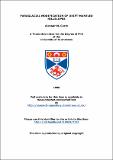Files in this item
Paraglacial modification of drift-mantled hillslopes
Item metadata
| dc.contributor.advisor | Ballantyne, Colin | |
| dc.contributor.advisor | Walden, John | |
| dc.contributor.advisor | Warren, Charles | |
| dc.contributor.author | Curry, Alastair M. | |
| dc.coverage.spatial | 350 p. | en_US |
| dc.date.accessioned | 2015-08-04T10:48:10Z | |
| dc.date.available | 2015-08-04T10:48:10Z | |
| dc.date.issued | 1998 | |
| dc.identifier | uk.bl.ethos.542901 | |
| dc.identifier.uri | https://hdl.handle.net/10023/7115 | |
| dc.description.abstract | The aim of the research reported in this thesis is to establish the characteristics of paraglacial modification of drift-mantled hillslopes in glaciated upland valleys in Norway and Scotland. Debris flow represents the principal agent of paraglacial sediment reworking, though snow avalanches and slopewash are locally important. Paraglacial hillslope modification is most widespread in areas of thick drift where initial slopes exceed c. 30°, void ratio exceeds c. 0.35, and water input is focused both spatially and temporally. Paraglacially-reworked sediments preserve most of the characteristics of the parent tills, but differ in terms of preferred clast orientation and structural and lithofacies characteristics. Stratigraphic relations between tills and reworked sediments imply cyclic alternation of glacial and paraglacial sediment transport. Paraglacial slope adjustment follows a sequence involving (1) rapid gully incision; (2) widening of gullies, and accumulation of debris cones at the slope foot; (3) reduction and destruction of inter-gully divides, and formation of a slope-foot apron of coalescing cones; (4) extensive exposure of bedrock at the crest of the slope, resulting in sediment exhaustion and progressive stabilisation. Slope profiles tend to converge on a maximum gradient of c. 28° and a concavity index of c. 0.22. At the most active sites, 2-4 m of gully lowering has occurred within decades of deglaciation, implying minimum erosion rates averaging c. 90 mm yr ⁻¹. In Scotland delayed or renewed reworking of drift-mantled slopes has occurred several millennia after deglaciation. Radiocarbon dating of buried palaeosols indicates intermittent drift reworking by debris flows throughout the past 6.5 ka, with some evidence for accelerated activity at c. 2.7-1.7 cal ka BP and after c. 0.7 cal ka BP. Three-dimensional conceptual models are developed to describe the sequence of both immediate and delayed or renewed paraglacial hillslope modification, and the landforms and sediment associations characteristic (and diagnostic) of paraglaciallandsystems in passive continental margins. | en_US |
| dc.language.iso | en | en_US |
| dc.publisher | University of St Andrews | |
| dc.subject.lcc | GB586.C9 | |
| dc.title | Paraglacial modification of drift-mantled hillslopes | en_US |
| dc.type | Thesis | en_US |
| dc.type.qualificationlevel | Doctoral | en_US |
| dc.type.qualificationname | PhD Doctor of Philosophy | en_US |
| dc.publisher.institution | The University of St Andrews | en_US |
This item appears in the following Collection(s)
Items in the St Andrews Research Repository are protected by copyright, with all rights reserved, unless otherwise indicated.

